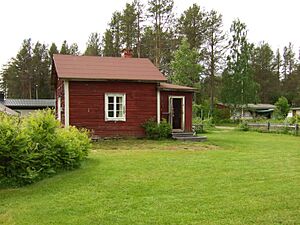Kalervo Palsa facts for kids
Quick facts for kids
Kalervo Palsa
|
|
|---|---|
| Born | 12 March 1947 Kittilä, Finland
|
| Died | 3 October 1987 (aged 40) Kittilä, Finland
|
| Occupation | Artist |
Huugo Kalervo Palsa, known as Kalle (12 March 1947 – 3 October 1987), was a Finnish artist whose style has been described as fantastic expressionism.
Although his work did not draw significant attention in his lifetime, Kalervo Palsa's reputation grew after being the subject of exhibitions and writings following his death. In 2013, a film based on his life, Kalervo Palsa ja kuriton käsi was released. In 2013, his house was converted into the Palsa Museum, dedicated to his work.
Life
Palsa was a native of Kittilä in Lapland. As a child, he grew up in a dysfunctional household where display of emotion was discouraged.
Palsa began keeping a journal in which he recorded his thoughts in the early 1960s. His work was first exhibited in Rovaniemi in 1967, and he became the first member of his family to graduate high school in 1970. He spent time in the 1970s as an art student in Helsinki, but resided permanently at a small studio cabin in Kittilä. It was connected to electricity by a long extension cable from a nearby house, and Palsa called it his "Getsemane" after the biblical site, or sometimes his "castle in the clouds".
Palsa died in 1987, lying in bed at home alone with pneumonia.
Legacy
During his life he had artist friends including Reidar Särestöniemi, but his two biggest supporters were his mother, and his soulmate/muse Maj-Lis Pitkänen, the sister of his childhood sweetheart Maaret.
After his death, Maj-Lis was bequeathed his artistic works and journal, and donated them to the Kiasma art museum in 1999. She would later go on to curate several exhibitions of his work and to edit compilations of his writings. She led a long-term campaign to install a memorial cenotaph for Palsa, which was sculpted by the Finnish artist, Pekka Pitkänen, Maj-Lis's husband.
Art
Kalervo Palsa used a varied palette of techniques and materials, including housepaint. He painted over 1,000 self-portraits.
Most of his works explore in graphic detail the dark side of humanity, and especially of his native northern regions.
Palsa went through a brief phase of experimentation with abstract art while staying in New York City. According to his diaries, this phase ended suddenly one day when he saw an unconscious black man sprawled on a subway bench.
Besides Hieronymus Bosch, his work has been compared to that of Frida Kahlo. His artistic influences include René Magritte and Vincent van Gogh, and his works also include references to Jean-Paul Sartre, August Strindberg and Jean Genet. On the first page of Eläkeläinen muistelee, he mentions other looser influences such as Jonathan Swift and Vladimir Lenin, among others.
Some researchers have noted that though he remained active in his work up to his death in 1987, his work did not show signs of the postmodernism evident in the work of many other artists of the time.




